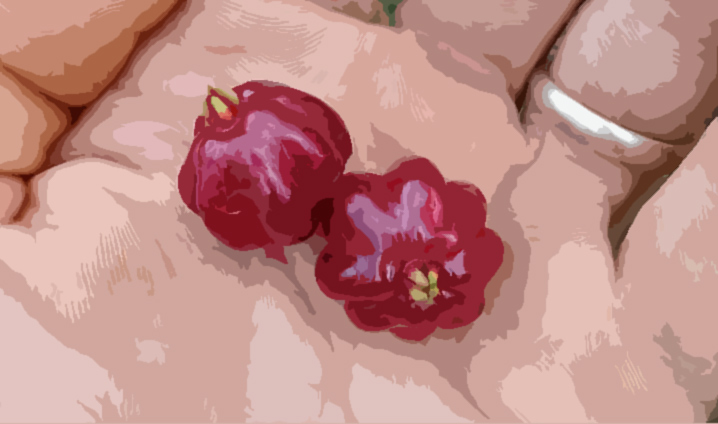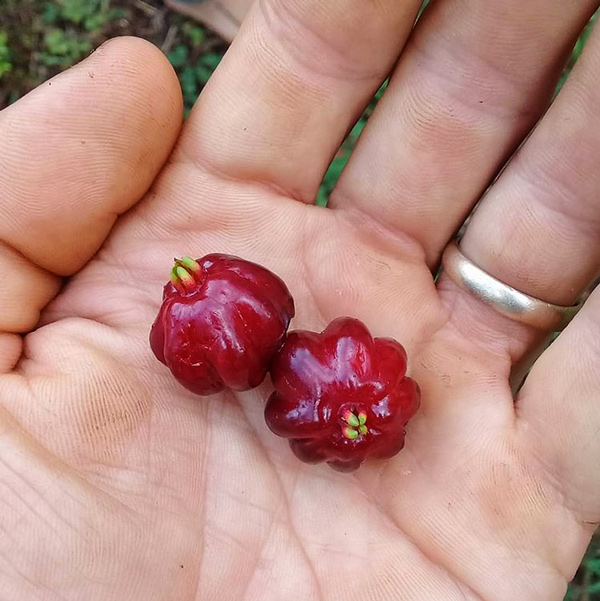Surinam cherry is one of the best cherries I have ever had. When I first saw it, I was a bit doubtful. The variety we have growing is a dark red type, and is small and ribbed. It was unlike the normal, red and very smooth cherry I normally saw. But when I ate it, I was surprised. It was delicious. It is the most flavorful cherry I have ever had. There are a few planted in the Great South Florida Food Forest Project, and my Dad got one to grow in North Florida in a semi-sheltered area.
Surinam cherry is a very pretty plant. It can get up to 25 feet. It has light green foliage and small fruit ranging from bright red to dark purple. There are two distinct types: a common one producing bright-red cherries, and a more rare type which produces dark-crimson to almost black fruit. The black type is usually sweeter and has a less resinous flavor, though some of the reds are very good and also don’t have the resin flavor less-good varieties are known for.
This is the red type that is currently fruiting for us:
How to Prepare and Eat
Though Surinam cherries are great eaten right off the plant, there are a few different things you can do with them. Morton reports that you can use them to put on top of cakes instead of strawberries. They are also a good addition to ice cream and custard. Brazilians ferment the juice into vinegar or wine.*
For cherries with some varnish flavor, Green Deane writes: “If you slice ripe ones open, take out the seeds, and the fruit sit in a refrigerator for a couple of hours they lost much of the resinous tang.”
Propagation
Surinam cherries can be grown by seed or by cuttings. To start by seed, eat a cherry and plant the seeds into a pot and water them daily until they germinate. Seeds take three to four weeks to germinate. They can be transplanted into the soil when they are about a foot tall. They thrive in full sun. Water them once a week when there is no rain.
Though we have not tried it, The San Fransisco Gate has information on growing Surinam Cherry from cuttings.
Where Surinam Cherry Grows
Surinam Cherries grow in tropical to subtropical regions. Adult trees can not endure temperatures under 22º F. Surinam cherry loves full sun, and can endure a long dry season. They grow in almost any kind of soil.
Additional Uses
The bark of Surinam cherry can be used for treating leather. The flowers are a rich source of pollen for honeybees.
You can learn more about Surinam cherries in this post from last year.
SPUDOMETER RATING:
Name: Surinam Cherry, Pitanga, Brazilian Cherry, Cayenne Cherry, Florida Cherry
Latin Name: Eugenia uniflora
Type: Large shrub/small tree
Nitrogen Fixer: No
Medicinal: Used to decrease blood pressure and prevent heartburn, bronchitis, colic and stomachaches.
Cold-hardy: Adult trees can not endure temperatures below 22° F.
Exposure: Full sun
Part Used: Fruit, bark
Propagation: Seeds, cuttings
Taste: Melting, very juicy, acid to sweet taste
Storability: A month in the fridge
Ease of growing: Easy
Nutrition: Good source of vitamin A and vitamin C
Recognizability: Low
Availability: Low
* https://hort.purdue.edu/newcrop/morton/surinam_cherry.html




5 comments
“Varnish” heh.
My Dad used to call these things “kerosene cherries” because of that flavor.
That is a great name.
Mine o my started fruiting this year after pruning it. Our flavor is more like a sweeter beginning with floral and perfume taste at the end. Right now, I am trying different methods to remove the perfume taste. A little challenging but I like experimenting! Ps – I lost a lot of fruit to the birds, until I wrapped fake snakes around the fruiting areas – problem solved!
Mine tastes terrible like gasoline
If you cut them open, when fully ripe, and let them sit out for a few hours in the fridge, that taste will dissipate. But improved varieties taste much better.
Comments are closed.